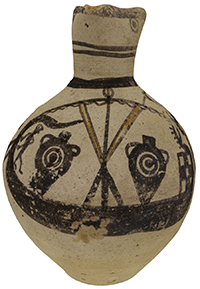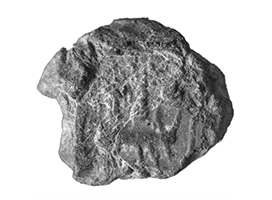Ship facing left with a crescentic hull and high incurving posts. The stempost rises vertically high above the sheer, bending sharply inwards at a 90o angle then upwards again. The sternpost rises vertically then curves inward smoothly. The sail is trapezoidal in shape. The two vertical poles jutting midway from the hull are most probably the mast step system, with the line in the middle of the sail being the mast. The rigging is represented by a forestay and backstay. There were five oars jutting below the hull, four of which survive.
Clay pendant seal
L56
9th century B.C. Iron IIA
Tel Abel Beth Maacah, acropolis casemate structure
H: 2.45 cm; Base Diam: 1.9–1.8 cm
Clay pendant shaped as a lotus flower. Hand formed and perforated at the narrow end, with a seal impression on the wide base. Near complete, with some scarring of the base and top broken at the perforation.
Reg. No. 67284
Brandl and Yahalom-Mack 2022
Tel Abel Beth Maacah is located at the interface of the northern Kingdom of Israel, the Kingdom of Aram-Damascus, as well as the Phoenician city-states of Tyre and Sidon some 35 km to its west. The excavators identify the site as having an Israelite affiliation with strong Phoenician cultural elements present (Yahalom-Mack et al 2021). Tel Abel Beth Maacah was inhabited throughout Iron I. Following a destruction in the 10th century B.C., it continued to have a significant Iron IIA occupation (Yahalom-Mack, Panitz-Cohen and Mullins 2018). The upper northern part of the mound during this period was dominated by a citadel complex comprised of a large casemate structure, auxiliary rooms, installations, courtyards and silos (Yahalom-Mack et al 2021: 3-4). Pottery and 14C samples date this citadel between the late 10th to 9th centuries B.C. The pendant was recovered from a semi-circle of stones built against the outside of the northern wall of the casemate-like building in Area B (Locus 6743, Square G/20, Area B, Stratum B-4), which possibly functioned as a shallow bin (Brands and Yahalom-Mack 2022: 244).
The material culture of Tel Abel Beth Maacah exhibits various Phoenician elements, including a large number of Phoenician pottery which points to the close connection of the site with the nearby Phoenician coast. It has been hypothesized that the site likely provided agricultural goods to the Phoenician cities, as suggested by a silo and numerous contemporaneous ovens in the lower city (Area A) that may indicate large-scale food processing (ibid: 246). Jars found at the site likewise exhibit standardization (shape, size, surface treatment, formation techniques) which points to a specialized mode of production that was probably centralised under the oversight of a local authority (Yahalom-Mack et al 2021: 15). The find context of the pendant, closely associated with the high-status residents of the casemate citadel on the acropolis, may further point to the elites’ close connection to this commercial activity (Yahalom-Mack, Panitz-Cohen and Mullins 2018).
The object is not a stamp seal in the sense that it was itself stamped rather than being manufactured as a stamp. Its shape is reminiscent of a lotus flower, an impression further reinforced by additional decoration using incised lines that include: an incised pair of horizontal parallel lines, a third parallel line beneath them at the point where the object tapers, and vertical asymmetric lines below the former. The base is oval without a frame. Given that the object was stamped, its use as a stamp would have produced a negative impression, which is unusual. When worn as a pendant, the motif however would not have been visible, which favours a functional use as a sealing device.
The best, near identical morphological parallel for the hull is a Cypro-Archaic pictorial representation from Cyprus (C4). The Akko altar graffiti likewise provide a good parallel (L6), although in their case the sharply incurving stempost does not rise upwards. The identification of the ship as Phoenician in origin by Brandl and Yahalom-Mack is correct (Brandl and Yahalom-Mack 2022: 246). Although the above mentioned parallels point to the Cypro-Phoenician sphere more broadly, the choice of medium is decidedly in favour of a specifically Phoenician identification. Based on a growing number of finds, seals have emerged as one of the preferred mediums for the Levant, in particular for the Late Bronze and Early Iron Age periods. The pendant’s Egyptianizing character provides further support to this argument.
The original publication has misread the stem for the stern. Their reading of the “three vertical poles” above the hull as a railing is also unlikely (ibid: 244). When reading the image correctly from the impression and not the sealing device itself, these become inversed and are in fact only two poles, which are roughly centered midway on the hull. This placement and the fact there are only two of them suggests they should be read as support for the mast step system. This interpretation is further strengthened by the longer pole above which is most likely the mast. Although it is not perfectly centered, giving some leeway for artistic clumsiness, it was obviously meant to be “framed” by the two shorter poles. A square mast step system is attested from the Tell Tweini seal (L20), providing a parallel from the region on the same medium. Lastly, the interpretation of the sternpost (in actuality the stem) as having a “roof shelter” should also be rejected (ibid: 245-246).
Brandl, B. and Yahalom-Mack, N. 2022. “A Clay Pendant with an Impression of a Phoenician Seagoing Ship from Tel Abel Beth Maacah,” in Davidovich, U. Yahalom-Mack, N. and Matskevich, S. (eds.). Material, Method, and Meaning: Papers in Eastern Mediterranean Archaeology in Honor of Ilan Sharon. Tubingen, pp. 241–252.
Yahalom-Mack, N., N. Panitz-Cohen, C. A. Rollston, A. Cohen-Weinberger, and R. A. Mullins. The Iron Age IIA ‘Benyaw Inscription’ on a Jar from Tel Abel Beth Maacah,” Palestine Exploration Quarterly: 1-23.
Yahalom-Mack, N., Panitz-Cohen, N., and Mullins R. A. 2018. ‘From a Fortified Canaanite City State to a “City and a Mother” in Israel: Five Seasons of Excavation at Tel Abel Beth Maacah’, NEA 81, 145–56.






